The word « maroquin » from the fifteenth century referred to Moroccan leather, « la maroquinerie » refers now to the leather business. That's how old this tradition is, mainly in Fez where one can still see the leather tanneries with their colorful and foul tanks.
The leather work is a tradition linked to many cities in the kingdom of Morocco such as Fez, Meknes, Marrakech, Rabat, Tetouan, Tangiers, from where come half the production of leather. Over time, this tradition lasted since today. One finds whole neighborhoods with colorful tanks, where many tanners are activated as in Fez and Marrakech and offer a quite extraordinary spectacle.
From the tanned hides of goats, sheeps or cow leather, Moroccan artisans make:
- round or pointy embroidered slippers for women;
- horse or camel saddles in the Saharan regions;
- leather bags and cases for daggers often embroidered with colored threads;
- ottomans, wallets, hats to meet the strong demand from tourists.
Nowadays, the leather business is an important source of revenue for the country, since it ranks first in exports of handicrafts after the carpet.
The leather craft holds an important place in the Moroccan trade and the history of the country. Marrakech remains the biggest center of the south in the processing and trade of wool and skins as evidenced by its name which comes from « maroquin ».
The leather work involves three trades, tanners, dyers and leather workers. You can still see these businesses and the entire production chain in the souk. Each city and region have their specialty, color embroideries are one of the ocher city. The leather used to make many items, wallet, bag, belt, ottoman without forgetting the famous slippers that give this look so peaceful to Moroccan. Unified color for men slippers while women slippers are embroidered. In the souk, many shops offer a variety of objects of all colors.

Leather Tanning has a long tradition in the Maghreb. Marrakech is undoubtedly the most famous of the great cities of North Africa that offers traditional tanneries. But this ancient craft is still practiced in many other cities of Morocco and Tunisia. The skins used most frequently are the skins of sheep and goat. The camel leather, more exclusive, is less common and more expensive, but it has an excellent reputation for quality and durability.































